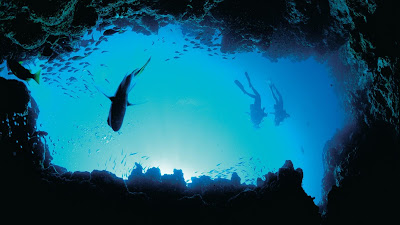ABU GALLUMManaged Resources Protected Area
Abu Gallum Protected Area was established by the Prime Ministerial Decree no.1511/1992 covering 458 Km2 named “Managed Resources Area” of which 121 km2 sea. After that, this area was extended by Decree no.33/1996 reaching Nuweiba-Taba marine section “Environmental Managed Area”, resulting in increasing the marine area, reaching 856 km2. This section including three main areas with special conservation (Pharaon Island, Fjord Bay and Solar Lake in Taba) as adjacent area.
Abu Gallum contains various coastal and mountain ecosystems that are unique to Gulf of Aqaba. The coral reef is mostly undisturbed with a high diversity of reef fish, whose richness of its flora and fauna is overwhelming. Probably, Abu Gallum is one of the most beautiful protectorates in Egypt, with its high mountains, wades, freshwater springs, picturesque sand dunes, coral reef and gravel alluvial fans; this area hosts about 165 plant species, about 45 of these species can only be seen in Abu Gallum and are unique to this area.
The researcher has suggested that Abu Gallum is a floristic frontier falling under the influence of a tropical climate but having predominantly Mediterranean conditions.
Recent studies conducted by researchers in Abu Gallum Protectorate recorded 162 species of marine macro-invertebrates (Echinoderms, Crustacean and Mollusks) associated with coral reefs, which play an important role in the marine ecosystem balance and vitality.
The reef at Abu Gallum supports an active Bedouin artisanal fishery. Fishermen from Nuweiba and Dahab practice subsistence fishing and supply local restaurants with fish and shellfish products.
The fishery is now regulated by the EEAA to reduce damage to the coral reef. The reef can be viewed at marked, safe access entry points.
Abu Gallum plain is narrow and this protected area plays an important part in regulation land use. It also acts as a buffer zone between land development focal points along the coast, while working to protect the natural resources that form the backbone of the local economy and are a great part of the area's attraction for tourists.
The Protectorate is a sensitive area that receives a high conservation priority. Access to regions without vehicle track systems can only be permitted where marked trails have been prepared. Bedouin guides and camels can be hired if requests and arrangements are made at the ranger house located at the mouth of Wadi Rasasah.
A visitor centre located at the northern boundary of Protectorate. It houses a small audio-visual theatre and displays concentrating on the flora and fauna of the Protectorate. information on dive sites and areas to be avoided. It should be noted the access to the underwater caves at Ras Mamlah is strictly forbidden. This cave system, extending to depths extending 100 meters, is unstable and deadly. Divers have been lost and not recovered from its depths.
Access to Abu Gallum
There are three entrances leading to tourist attractions and camping areas, the first entrance from Dahab city and the start of the famous Dive site the Blu Hole and enter by camels or walk on foot a distance of 7 km from the sea directly in the shadow of mountains, the second entrance through the Road Wadi Rasasah by four-wheel-drive cars and enjoy safari, show mountains and landscapes 35 km in Wadi and the last entrance through the coastal road from Nuweiba 50 km through the most protected landmarks to camping areas and Bedouin communities.
Tourist attractions
Blu Hole
Blue Hole is the most important and beautiful dive sites all over Egypt and is characterised by the presence of biological diversity in ornamental fish and coral reef Habitats, there is also a great diversity in caves underwater at different depths attract lovers of diving adventures.
The site is easily accessible to its proximity to Dahab city attracts fans of professional freediving and scuba diving and snorkelling, Depth up near the beach about 100 meters so it is held by many free diving competitions sport.
AL-Dahayla Village
This is one of the most important tourism regions in Abu Galum protected area, the local communities of Bedouin inhabiting this village and one of the camping areas for tourists and there is ancient nomadic life associated with the culture and heritage of the local community of crafts, handicrafts and provides the local population with food and drinks to visitors. It also features a place of high biodiversity of coral reefs and ornamental fish which are still virgin and watch Napoleon fish and endangered sea turtles in dive sites.
Blue Laguna
Is one of the hottest areas attract visitors in Abu Galoum Protectorate. Quiet, and is considered an aesthetic view featured a camping area.
Blue Laguna is considered a natural shelter for fish fry shelter in which to mature and go out to the open water. Where you can practice water sports that rely on the wind.
Wadi El-Okdah
It is one of the largest and most important Wadies and has a large reserve of flora and wildlife diversity. It has a okdah well which is the most important sources of drinking water for the local community and has its many fresh water wells and dams in Wadi.



















Comments